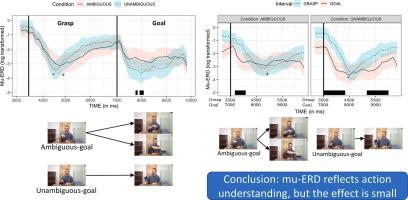当前位置:
X-MOL 学术
›
Brain Res.
›
论文详情
Our official English website, www.x-mol.net, welcomes your feedback! (Note: you will need to create a separate account there.)
Mu-ERD reflects action understanding, but the effect is small
Brain Research ( IF 2.9 ) Pub Date : 2024-03-16 , DOI: 10.1016/j.brainres.2024.148854 Lawrence Paul Behmer
Brain Research ( IF 2.9 ) Pub Date : 2024-03-16 , DOI: 10.1016/j.brainres.2024.148854 Lawrence Paul Behmer

|
Since the mid-2000’s, many researchers have provided evidence that mu-ERD measured at the motor cortex may reflect the collective activation of upstream brain regions associated with the human mirror system during action observation paradigms; however, several recent papers have called these findings into question. Our study represents an effort to address these criticisms. In our study, participants watched videos in which the type of grip an actor used to grasp a coffee mug either conveyed the goal with 100 % certainty (unambiguous-goal trials), or offered no predictive information (ambiguous-goal trials). If mu-ERD indexes action understanding, then we predicted that mu-ERD should increase while participants watched the actor grasp the mug for unambiguous-goal trials, but not for ambiguous-goal trials. During the intervals where participants watched the actor execute the goal, mu-ERD for unambiguous-goal trials should remain steady, whereas mu-ERD for ambiguous-goal trials should now increase. Conversely, if mu-ERD does not index action understanding, and instead reflects general motor processes associated with action (such as the activation of population vectors in M1 or planning processes), then mu-ERD should show no difference across conditions. Across most comparisons, we found that mu-ERD mostly reflected general motor processes; however, there was a small effect when participants overserved unambiguous-goal trials while watching the actor execute the goal suggesting that mu-ERD does reflect mirroring, but the effect is small.
中文翻译:

Mu-ERD反映了动作理解,但效果较小
自 2000 年代中期以来,许多研究人员提供的证据表明,在运动皮层测量的 mu-ERD 可能反映了在动作观察范式期间与人类镜像系统相关的上游大脑区域的集体激活;然而,最近的几篇论文对这些发现提出了质疑。我们的研究代表了解决这些批评的努力。在我们的研究中,参与者观看了视频,其中演员抓握咖啡杯的握法要么 100% 确定地传达了目标(明确目标试验),要么不提供任何预测信息(模糊目标试验)。如果 mu-ERD 索引了动作理解,那么我们预测,当参与者观看演员抓住杯子进行明确目标试验时,mu-ERD 应该会增加,但对于模糊目标试验则不会。在参与者观看演员执行目标的时间间隔内,明确目标试验的 mu-ERD 应保持稳定,而模糊目标试验的 mu-ERD 现在应增加。相反,如果 mu-ERD 不索引动作理解,而是反映与动作相关的一般运动过程(例如 M1 或规划过程中群体向量的激活),那么 mu-ERD 在不同条件下应该没有差异。在大多数比较中,我们发现 mu-ERD 主要反映一般运动过程;然而,当参与者在观察演员执行目标时进行过度的明确目标试验时,效果很小,这表明 mu-ERD 确实反映了镜像,但效果很小。
更新日期:2024-03-16
中文翻译:

Mu-ERD反映了动作理解,但效果较小
自 2000 年代中期以来,许多研究人员提供的证据表明,在运动皮层测量的 mu-ERD 可能反映了在动作观察范式期间与人类镜像系统相关的上游大脑区域的集体激活;然而,最近的几篇论文对这些发现提出了质疑。我们的研究代表了解决这些批评的努力。在我们的研究中,参与者观看了视频,其中演员抓握咖啡杯的握法要么 100% 确定地传达了目标(明确目标试验),要么不提供任何预测信息(模糊目标试验)。如果 mu-ERD 索引了动作理解,那么我们预测,当参与者观看演员抓住杯子进行明确目标试验时,mu-ERD 应该会增加,但对于模糊目标试验则不会。在参与者观看演员执行目标的时间间隔内,明确目标试验的 mu-ERD 应保持稳定,而模糊目标试验的 mu-ERD 现在应增加。相反,如果 mu-ERD 不索引动作理解,而是反映与动作相关的一般运动过程(例如 M1 或规划过程中群体向量的激活),那么 mu-ERD 在不同条件下应该没有差异。在大多数比较中,我们发现 mu-ERD 主要反映一般运动过程;然而,当参与者在观察演员执行目标时进行过度的明确目标试验时,效果很小,这表明 mu-ERD 确实反映了镜像,但效果很小。



























 京公网安备 11010802027423号
京公网安备 11010802027423号